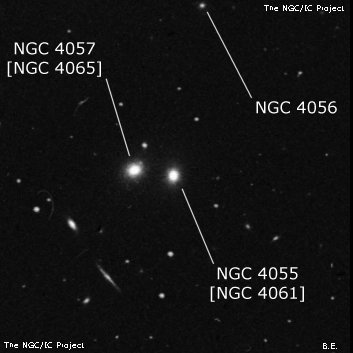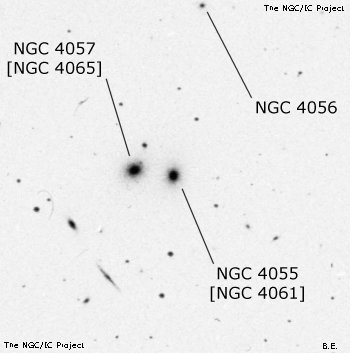NGC/IC Project Restoration Effort
(This is a very very beta version)
NGC4055


Basic Information
Location and Magnitude
Right Ascension: 12:4:1.5
Declination: +20:13:58
Constellation: COM
Visual Magnitude: 13.1
Historic Information
Discoverer: Herschel J.
Year of discovery: 1832
Discovery aperture: 18.3
Observational
Summary description: pB (PD very doubtful)
Sub-type: E3
Corwin's Notes
=====
NGC 4055 = NGC 4061, NGC 4057 = NGC 4065, and NGC 4059 = NGC 4070. John
Herschel found these three nebulae during his Sweep 423 on 29 April 1832.
They have not been positively identified in any published catalogue since,
though Reinmuth and PGC have made suggestions. Here is the story.
Steve Gottlieb started the case by noting that Reinmuth's identifications were
unlikely. Bob Erdmann followed up with the suggestion that these might be
identical to some of the galaxies in the NGC 4065 group 0.8 deg south. Then,
Brent Archinal suggested a check of the other objects seen by Herschel in
the same sweep. Here is what is in his 1833 catalog credited to Sweep 423
(there may be one or two others lurking in the list, but I haven't found them
in two reasonably careful searches. My comments are in square brackets):
NGC h RA (1830) NPD Desc
3937 1003 11 43 56 68 25.1 vF, S, R
4032 1049 11 51 49 68 58.2 pB, R, gbM, 40" [N.B. Seen in 5 other
sweeps where the brightness ranges
from "B" to "eF"; the positions agree]
4055 1062 11 55 00: 68+- pB
4057 1063 11 55 04: 68+- pB
4059 1064 11 55 08: 68+- pB. On merid[ian] with two more [I presume
the other two are N4055 and N4057]
4066 1068 11 55 26 68 41.9 No description [Seen in 3 other sweeps;
the positions agree. Those descriptions
are "Not vF. Another seen", "pB", and
"The third of 5"]
4095 1079 11 57 13 68 28.1 eF [seen in one other sweep; position agrees,
but no description]
4098 1082 11 57 22 68 25.5 No description [two other sweeps: positions
agree; "vF, R, bM" and "No description"]
Looking at this table, I was struck by a couple of things. First, the north
polar distances of the three questionable objects have been assigned the same
number of degrees as the other five objects. This suggests to me that the
minutes of NPD should be similar to the others -- say 68 30 to 68 50 -- since
Herschel's sweeps were pretty limited in declination. This would make the
NPD's roughly equivalent to the other bright objects in the core of the NGC
4065 group where the NPD's range from 68 38 to 68 53. Second, the
descriptions suggest that the objects are not faint, and that they are aligned
pretty closely along the same meridian of RA.
The NGC 4065 group has four bright objects: N4061, N4065, N4066, and N4070.
Since Sir John saw N4066 during the sweep in question, this leaves N4061,
N4065, and N4070 as the possible candidates. Interestingly, his more exact
positions for N4055, 57, and 59 given in GC (from "a most careful
consideration of all the observations and records in the sweeping books" [note
in GC], and copied into NGC by Dreyer) are roughly coincident with these three
galaxies if a systematic offset of about -0.88 degrees in Dec and +20 seconds
in RA is applied.
Putting all this together, Occam's Razor (the simplest hypothesis that fits
the facts) suggests that
NGC 4055 = NGC 4061
NGC 4057 = NGC 4065
NGC 4059 = NGC 4070
I'm not sure about this, of course. But this is certainly a reasonable
solution to the problem.
There is more discussion of the identities in the group under NGC 4056 and NGC
4069.
Steve's Notes
=====
NGC 4055
See observing notes for NGC 4061.



